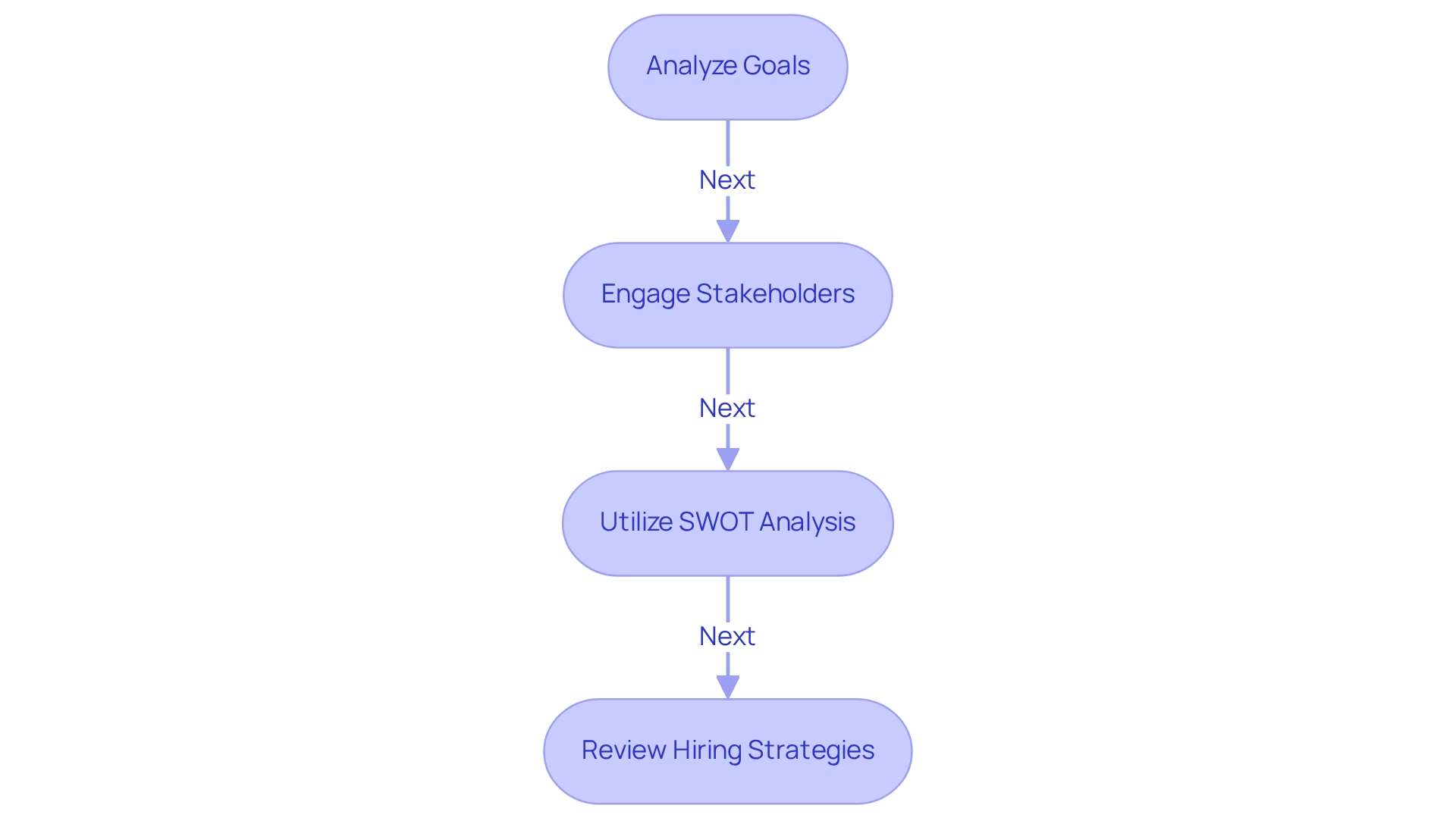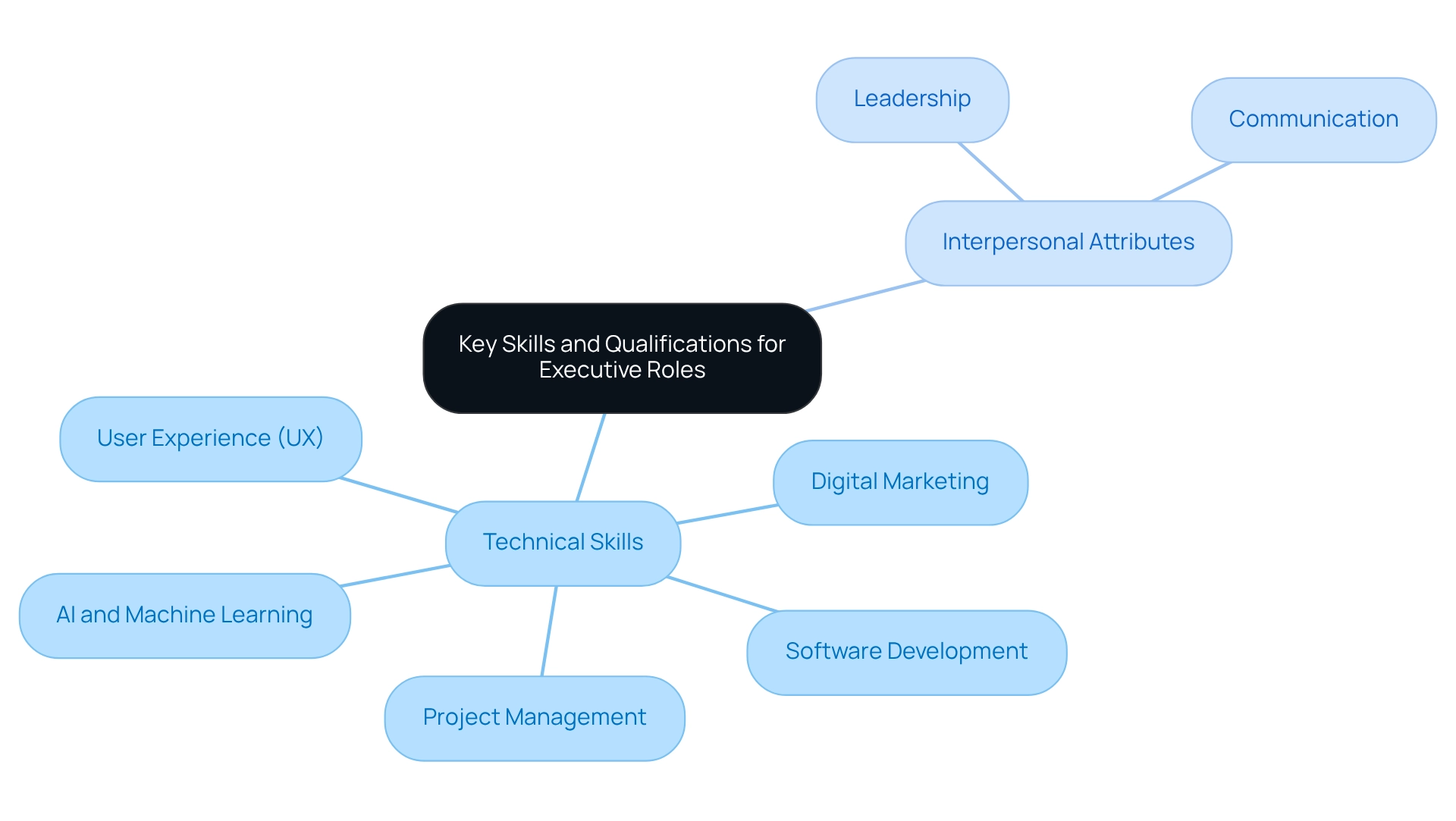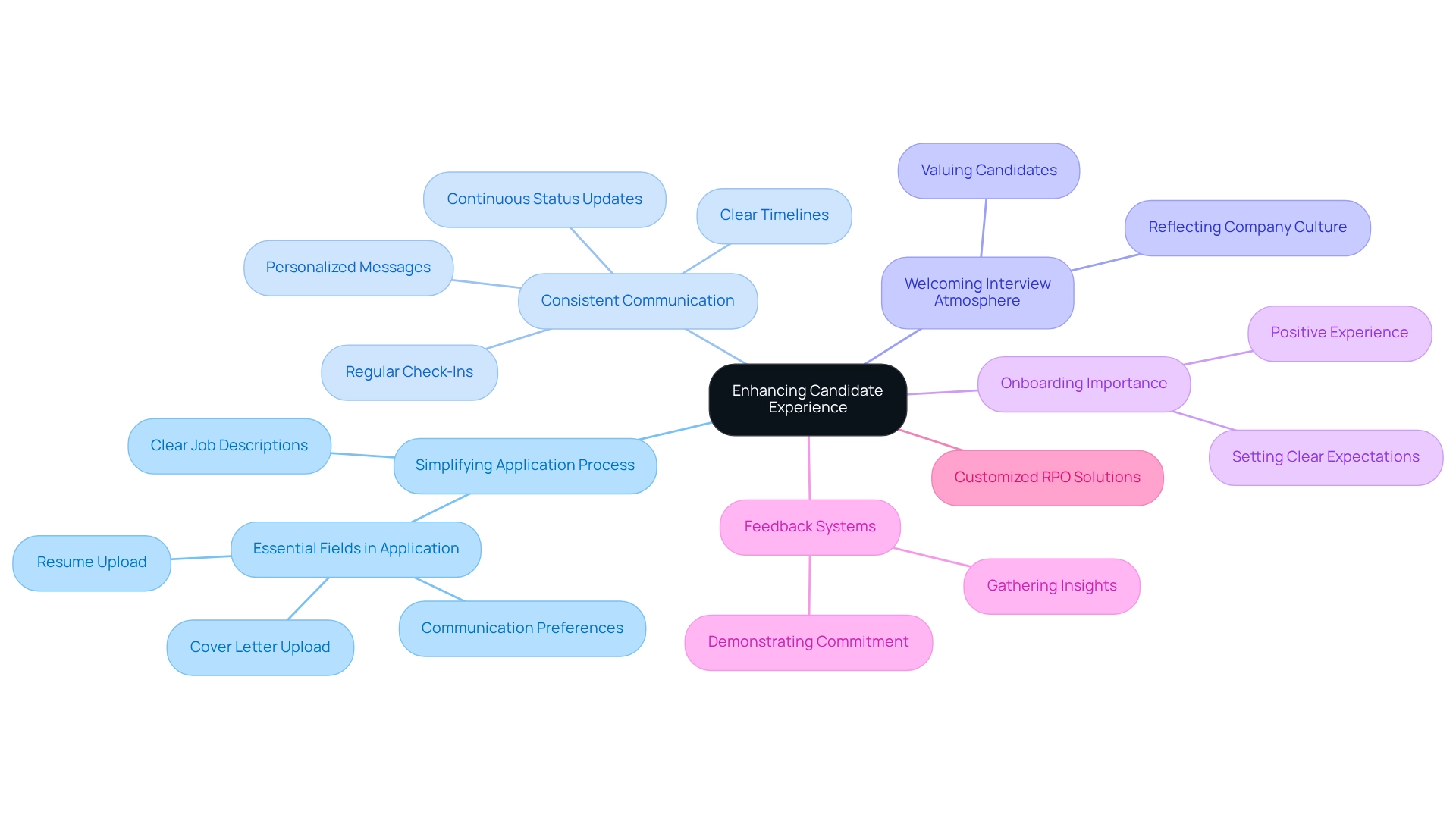Overview
This article delineates four pivotal strategies for achieving success in executive hiring:
- Defining organizational needs
- Identifying key skills
- Implementing a structured recruitment process
- Enhancing the candidate experience
Each strategy is substantiated by compelling evidence. For instance, stakeholder engagement is crucial for accurately defining organizational needs. Additionally, there is a notable shift towards skills-based recruitment, which underscores the importance of recognizing essential competencies. The implementation of structured interviews and applicant tracking systems has proven effective in streamlining the recruitment process. Finally, fostering a positive candidate experience is indispensable for attracting top-tier talent. By understanding and applying these strategies, organizations can significantly improve their hiring outcomes.
Key Highlights:
- Define organizational needs by analyzing current and future goals and engaging key stakeholders for insights on required skills.
- Boutique Recruiting specializes in sourcing validated talent for both onsite and remote executive roles with an 88% conversion rate.
- Utilize SWOT analysis to identify recruitment influencing factors and document findings for a clear candidate profile.
- The trend towards skills-based recruitment is rising, with 68% of employees preferring this approach, necessitating alignment with strategic objectives.
- Key skills for executive roles include software development, UX, AI, project management, and digital marketing, essential for a tech-driven economy.
- Structured recruitment processes enhance efficiency, with uniform interview questions improving applicant evaluation and forecasting job performance.
- Applicant tracking systems (ATS) streamline hiring and maintain organized records, aiding HR managers in monitoring recruitment effectiveness.
- Diverse evaluation methods, including behavioral interviews, provide a comprehensive view of applicants’ capabilities.
- Enhancing candidate experience through simplified applications, clear communication, and welcoming interviews attracts top talent.
- Onboarding is crucial for positive applicant experiences, with 75% of employees agreeing on its importance for retention and engagement.
Introduction
In the competitive landscape of executive hiring, organizations must navigate a complex web of strategic objectives and evolving market demands. As the landscape shifts towards skills-based hiring, it becomes imperative for companies to clearly define their organizational needs and identify the key competencies required for leadership roles. This article delves into the essential steps for refining recruitment strategies.
From engaging stakeholders to implementing structured processes that enhance candidate experience, a comprehensive approach is crucial. By focusing on these elements, organizations can not only attract top talent but also align their hiring practices with long-term goals. This alignment ensures that each placement contributes to a thriving workplace culture and sustainable success.
Define Organizational Needs and Strategic Objectives
To effectively define organizational needs and strategic objectives for executive hiring, it is essential to start with a comprehensive analysis of the company’s current and future goals. Engaging key stakeholders—such as senior management and department heads—is crucial for gathering insights on the specific skills and competencies required for executive roles. Boutique Recruiting, a comprehensive staffing agency, specializes in sourcing top-notch professionals across various sectors in the U.S. and Canada, ensuring that companies connect with validated talent prepared for both onsite and remote opportunities. Our direct-hire placement services boast an impressive conversion rate of 88%, facilitating firms in finding the right fit for their strategic vision. Utilizing tools such as SWOT analysis can assist in identifying strengths, weaknesses, opportunities, and threats that may affect recruitment decisions. Documenting these findings will create a clear profile of the ideal candidate, ensuring alignment with the organization’s strategic vision. This clarity not only streamlines the executive hiring process but also facilitates informed decision-making throughout, ultimately enhancing the effectiveness of placements. As the trend towards skills-based recruitment continues to grow, with 68% of employees expressing a preference for this approach—a 21% increase from last year—aligning executive hiring practices with strategic objectives becomes increasingly vital for organizational success. Moreover, to foster a healthier work environment, HR professionals should prioritize fair compensation to mitigate financial stress, as emphasized by Christopher Pappas. Companies with varied management teams report 19% higher innovation revenue, underscoring the significance of inclusive recruitment practices.
To avoid common pitfalls in defining organizational needs, consider the following step-by-step approach:
- Conduct a thorough analysis of current and future organizational goals.
- Engage with key stakeholders to gather insights on required skills and competencies.
- Utilize SWOT analysis to identify factors influencing recruitment decisions. Document findings to create a clear candidate profile.
- Regularly review and adjust hiring strategies to align with evolving organizational objectives.

Identify Key Skills and Qualifications for Executive Roles
To effectively recognize essential abilities and qualifications for executive hiring in roles such as Chief Executive Officer, Chief Financial Officer, and Vice President, begin by thoroughly examining the job descriptions of current positions within your organization. This analysis should highlight common competencies that have contributed to successful performance in these roles. Focus on both technical abilities—such as financial acumen and strategic planning—and interpersonal attributes, including leadership and communication capabilities.
Integrating industry benchmarks and best practices is crucial to ensure that the identified competencies align with market expectations. For instance, by 2025, the most sought-after abilities are anticipated to encompass:
- Software and web development
- User experience (UX)
- AI and machine learning
- Project management
- Digital marketing
These competencies will be vital for success in a tech-driven economy, underscoring the necessity for continuous skill enhancement among job seekers. Notably, fewer than 40% of leaders express satisfaction with their company’s investment in their growth, emphasizing the need for firms to prioritize competency development.
Furthermore, consider the significance of diverse qualifications in executive positions. According to LinkedIn, employees without degrees tend to remain in their roles 34% longer than their degree-holding counterparts, indicating that a broader array of credentials can support retention and success.
Compile a comprehensive list of these essential abilities and qualifications, which will serve as a valuable reference throughout the candidate assessment process. This proactive approach not only enhances the quality of your recruitment decisions but also supports executive hiring that aligns your organization with the evolving demands of the executive landscape, as illustrated in the case study on skills needed by 2025.

Implement a Structured Recruitment Process for Effective Hiring
To create an efficient and organized recruitment process, begin by distinctly outlining each phase, from job posting to new hire onboarding. This clarity ensures that all team members are aligned and understand their roles. Uniform interview questions and assessment standards are crucial for evaluating applicants consistently and fairly. Research indicates that structured interviews can forecast job performance with a validity of 55%, underscoring their significance in the recruitment process.
At Boutique Recruiting, we specialize in customized recruitment solutions for high-demand finance, technology, and niche legal roles, ensuring that our approach aligns with the unique needs of your organization. The implementation of applicant tracking systems (ATS) can significantly enhance hiring efficiency by streamlining the application process and maintaining organized records of applicant interactions. This technology not only conserves time but also aids in monitoring the effectiveness of various recruitment strategies, making it a valuable resource for HR managers in financial firms.
Incorporate diverse evaluation methods, such as behavioral interviews and skills assessments, to gain a comprehensive view of each applicant’s capabilities. This multifaceted approach allows for a deeper understanding of how applicants may perform in real-world scenarios. Furthermore, considering fairness in recruitment is paramount; research shows that 57% of job seekers support anonymized hiring practices, which can help mitigate biases in the selection process.
Regularly reviewing and refining the recruitment process based on feedback and outcomes is essential for continuous improvement. Companies that invest in structured onboarding programs, for instance, experience higher retention rates and improved employee engagement, highlighting the long-term benefits of a well-implemented recruitment strategy. As Eric Eddy noted, Boutique Recruiting’s ability to provide high-quality individuals swiftly and effectively is a testament to the success of a structured approach. By adopting these best practices, companies can enhance their executive hiring processes and secure top talent effectively, including roles such as CFO, Financial Manager, and General Counsel.

Enhance Candidate Experience to Attract Top Talent
To enhance the applicant experience, organizations must prioritize the simplification of the application process. Clear and concise job descriptions are crucial, as they delineate key responsibilities and qualifications, facilitating applicants’ assessment of their fit. At Boutique Recruiting, we underscore the importance of essential fields in our job application form, ensuring applicants comprehend what is required—such as uploading their resume and cover letter and providing their communication preferences. Consistent communication throughout the recruitment process is vital; offering prompt updates and feedback can significantly elevate applicants’ overall experience. In fact, 81% of job seekers assert that continuous status updates would greatly enhance their journey. Establishing a feedback system enables businesses to garner valuable insights from applicants, guiding future enhancements and demonstrating a commitment to their experience.
Creating a welcoming interview atmosphere that reflects the entity’s culture and values is equally essential. This approach not only makes individuals feel valued and respected but also reinforces their awareness as consumers of the employer’s brand. By prioritizing these strategies, organizations can effectively attract and retain top talent, ultimately yielding successful executive hiring outcomes. Moreover, organizations should recognize the importance of onboarding; nearly 75% of employees agree it is crucial for a positive applicant experience. Transparency in hiring practices, as emphasized in our FAQs, highlights the necessity for applicants to be genuine and open about their goals and expectations, which can improve the overall experience by setting clear expectations and enhancing employer branding efforts. To bolster communication with applicants, HR managers can implement specific strategies such as:
- Regular check-ins
- Personalized messages
- Clear timelines for the recruitment process
Additionally, exploring customized Recruitment Process Outsourcing (RPO) solutions can provide tailored support to enhance the overall candidate experience.

Conclusion
In the dynamic landscape of executive hiring, organizations must refine their recruitment strategies to align with both strategic objectives and the competencies required for leadership roles. Conducting a thorough analysis of organizational needs and engaging key stakeholders enables companies to create a clear profile of the ideal candidate, streamlining the hiring process and enhancing placement effectiveness.
Identifying essential skills—both hard and soft—proves crucial in attracting top talent. Companies should also consider diverse qualifications that contribute to retention and performance, ensuring hiring practices remain relevant in a rapidly evolving market.
Implementing a structured recruitment process further strengthens the ability to secure high-quality candidates. Utilizing standardized interview questions, diverse assessment methods, and applicant tracking systems can enhance candidate evaluation and streamline operations. Additionally, prioritizing the candidate experience through clear communication and a welcoming interview environment reinforces the organization’s brand as an employer of choice.
In summary, a comprehensive recruitment strategy that emphasizes clarity in organizational needs, identifies key competencies, and enhances the candidate experience is vital for successful executive hiring. By adopting these best practices, organizations can effectively attract top talent and foster a thriving workplace culture, ensuring long-term success in an ever-changing hiring landscape.
Frequently Asked Questions
What is the first step in defining organizational needs for executive hiring?
The first step is to conduct a thorough analysis of the company’s current and future goals.
Why is engaging key stakeholders important in the executive hiring process?
Engaging key stakeholders, such as senior management and department heads, is crucial for gathering insights on the specific skills and competencies required for executive roles.
What services does Boutique Recruiting offer?
Boutique Recruiting specializes in sourcing top-notch professionals across various sectors in the U.S. and Canada, offering direct-hire placement services with an impressive conversion rate of 88%.
How can SWOT analysis assist in the executive hiring process?
SWOT analysis helps identify strengths, weaknesses, opportunities, and threats that may affect recruitment decisions, allowing for better-informed choices in the hiring process.
What is the significance of documenting findings during the hiring process?
Documenting findings creates a clear profile of the ideal candidate, ensuring alignment with the organization’s strategic vision and streamlining the executive hiring process.
What trend is influencing executive hiring practices currently?
The trend towards skills-based recruitment is growing, with 68% of employees expressing a preference for this approach, emphasizing the importance of aligning hiring practices with strategic objectives.
How does inclusive recruitment impact organizational success?
Companies with varied management teams report 19% higher innovation revenue, highlighting the significance of inclusive recruitment practices.
What step-by-step approach can help avoid common pitfalls in defining organizational needs?
The approach includes: 1. Conducting a thorough analysis of current and future organizational goals. 2. Engaging with key stakeholders to gather insights on required skills and competencies. 3. Utilizing SWOT analysis to identify factors influencing recruitment decisions and documenting findings to create a clear candidate profile. 4. Regularly reviewing and adjusting hiring strategies to align with evolving organizational objectives.
